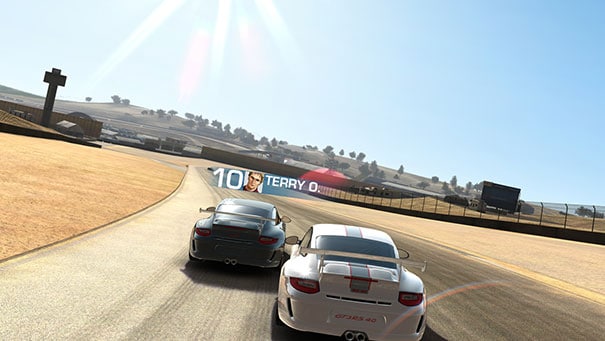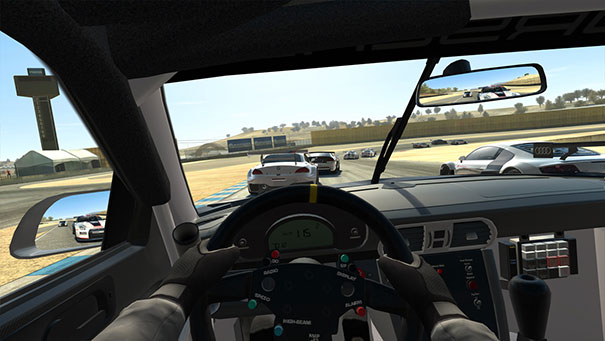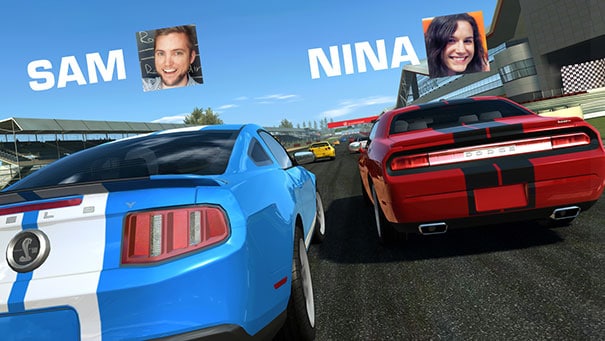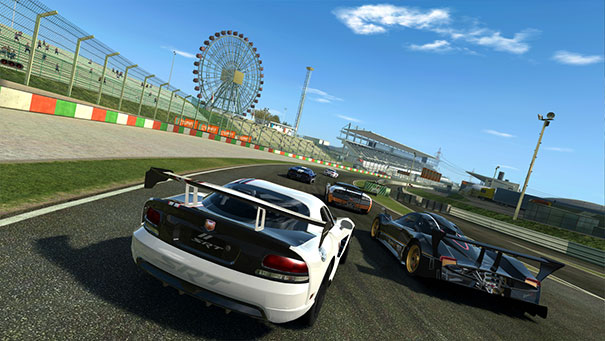For those of you who haven’t been gaming on Android and iOS, EA and Firemonkeys’ Real Racing 3 will probably be quite the eye-opener. The core game may be free, but you’ll soon find that immediate access to a lot of the goodies within it is gated by way of IAPs (in-app purchases). Simply put, you can’t experience everything in the game unless you fork out the dough. Welcome to the future.
But while most ‘freemium’ games section off certain items, levels or characters purely for a paying audience, Real Racing 3 isn’t quite as bad. For instance, almost all its cars seem to be available for purchase using currency you can earn in-game. Granted their price tags may be eye-watering, but I’d rather have this arrangement than not having access to them at all.

What this means from a gameplay perspective is lots of grinding. I’m not kidding – you’ll want to redo a lot of the events multiple times just to farm cash. Now while this almost always is a bad thing, Real Racing 3’s sumptuous graphics, 20+ car grids, and licensed cars (about 45 of them) and real-world tracks take it dangerously close to being harmless fun. You’re also treated to ‘Fame’ fueled driver level progression, a choice of camera views (including a full dashboard cam), performance upgrades, and a licensed soundtrack.
EA can try selling this as a sim, but it most definitely isn’t one from a handling perspective.
Whether the same degree of fun continues across the 900+ available events and multiple (yet finite) event types, however, is another story – and something no review can accurately gauge at the moment. Real Racing 3 comes with a metric tonnage of content and the promise of more to come via future updates. What does have the potential to get old fast though is the binary, digital steering. EA can try selling this as a sim, but it most definitely isn’t one from a handling perspective.
The cars stick to the road like glue and turn on a dime with assists enabled, whereas flicking them off necessitates judicious braking and cornering thanks to a lot of arbitrary sliding around the track. With assists on, it’s a game anyone can pick up and play. You don’t need to accelerate or brake, except to avoid traffic, and you only need to learn the track and the best racing line around it.

It also gives you plenty of opportunity to ogle the car and track graphics, which vary wildly from device to device. Real Racing 3 is best played on the iPad 4, with its new A6X processor and generous screen size. I also tried the game on a Gen 4 iPod Touch with favourable results. The framerate was smooth and there didn’t appear to be too much of a visual compromise either. You’ll notice a bit of framing when you go in and out of menus, however.
It’s a bit disappointing that features such as race replays and real-time multiplayer have been removed. Taking their place is an odd gimmick called TSM, or time-shifted multiplayer. What it’s supposed to do is asynchronously place real-life players on the track with you, so every race feels like you’re playing against real players. What the game actually does, however, is just mimic race times rather than their actual racing lines. The end results are processions of cars that just feel like they’re traffic you need to get by. You never feel like you’re in a race with intelligent opponents, and they’ll go so far as to completely ignore your presence on track and brake ultra-conservatively. There’s no character to the racing whatsoever, which is a huge disappointment.

Where things start to get interesting is in how the game handles its EA-delegated freemium mandate. Persistent damage applies across races, and you’ll eventually need to repair the inevitable nicks you accumulate as you race against the brain-dead competition. Also tracked persistently is the general wear-and-tear of your vehicles, necessitating services every few races. You use in game currency earned from winning races to repair damage and service your vehicles. However, some of the higher level vehicles upgrades and even paint schemes are locked behind gold coins – the game’s second form of currency.
It’s not enough to pay for the repairs and servicing – you’ll need to wait it out as well.
Muddying up the in-game economy even more, are the waiting times involved with each part of your car that you’re looking to attend to. It’s not enough to pay for the repairs and servicing – you’ll need to wait it out as well, unless you pony up tantalisingly scarce gold coins to skip them. These wait times also stack on top of one other as well, so wanting to service multiple parts at once will only make the wait times longer. New vehicles also come with a waiting period before they’re delivered to your garage.
EA lets you purchase currency, gold coins and car packs from their in-game store. There’s no compulsion to, but the option’s there should you happen to have more real-world money than you know what to do with. As divisive as freemium models are, I try and look at the positives. You’re essentially getting a near-console quality game with more content than it honestly knows what to do with, all for free. There’s no feeling of being railroaded into paying real-world money in order to progress. Sure, there are wait times – but buy a handful of cars, and you’ll soon learn to manage sending one to the mechanic while you race another.

Also worth remembering is that, believe it or not, the game had longer wait times during its limited Australasian release. These were then eventually trimmed before the worldwide launch, so there’s always room for Firemonkeys to change things up as they receive feedback.
Conclusion
All said, my primary concerns are with the emphasis on grinding, mostly thanks to paltry race purses, the abysmal competition, and the lack of true multiplayer. Combined with a driving model without any real feedback and a dodgy in-game economy, Real Racing 3 isn’t the quality sequel Real Racing 2 deserved. It isn’t disappointing because its freemium; it’s just a disappointing driving game.




